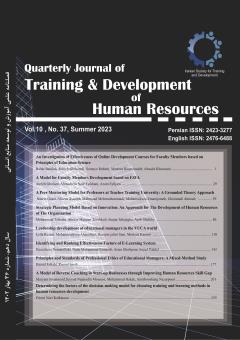-
-
List of Articles
-
Open Access Article
1 - An Investigation of Effectiveness of Online Development Courses for Faculty Members based on Principles of Education Science
Bahar Bandali Razieh Shahverdi Somaye Rahimi Morteza Rezaeizadeh Abasalt Khorasani -
Open Access Article
2 - A Model for Faculty Members Development based on FAVA
Atefeh Gholami Ahmadreza Nasr Esfahani Azam Esfijani -
Open Access Article
3 - A Peer Mentoring Model for Professors at Teacher Training University: A Grounded Theory Approach
nasrin ozaei alireza assareh Mahmoud Mehrmohammadi mohamadreza emamjomeh gholamali ahmadi -
Open Access Article
4 - Strategic Planning Model Based on Innovation: An Approach for The Development of Human Resources of the Organization
Mohammad Tafreshei Alireza Manzari tavakkoli sanjar salajeghe ayob sheikhy -
Open Access Article
5 - Leadership development of educational managers in the VUCA world
Leila Rezaei MohammadReza Ahanchian Hossein Jafari Sani Morteza Karami -
Open Access Article
6 - Identifying and Ranking Effectiveness Factors of E-Learning System
Hamidreza Nematollahi ندا محمداسمعیلی Arian Gholipour saeed پاکدل -
Open Access Article
7 - Principles and Standards of Professional Ethics of Educational Managers: A Mixed-Method Study
hamid falahi rasoul saedi -
Open Access Article
8 - A Model of Reverse Coaching in Start-up Businesses through Improving Human Resources Skill Gap
maryam javanmard Seyed Najmeddin mousavi Mohammad Hakkak Amir Houshang Nazaripour -
Open Access Article
9 - Determining the factors of the decision making model for choosing training and learning methods in human resources development
Dr Firouz Nouri Kalkhoran
-
The rights to this website are owned by the Raimag Press Management System.
Copyright © 2017-2025







